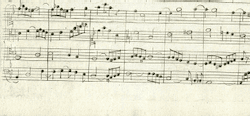In his influencial Abhandlung von der Fuge (1753), Friedrich Wilhelm Marpurg (1718–1795) uses the expression per arsin et thesin “to refer to the entrance of a theme (usually a fugue subject) with displaced accents, former strong beats becoming weak and vice versa” (Walker, Arsis, thesis). (Marpurg was a German author, music critic, music theorist and composer.)
In the 17th and 18th centuries, however, the expression per arsin et thesin was often ‘misused’ in the context of a counter-fugue (Gegenfuge, as Mattheson calls it in German), where it stood for imitation in contrary motion. In fact, the expression per arsin et thesin for imitation in contrary motion was a creation of the 16th-century composer and theorist Gioseffo Zarlino (1517–1590).
Select Bibliography
Demeyere, Ewald. Johann Sebastian Bach’s Art of Fugue — Performance Practice Based on German Eighteenth-Century Theory (Leuven: Leuven University Press, 2013).
Marpurg, Friedrich Wilhelm. Abhandlung von der Fuge (Berlin, 1753–1754).
Mattheson, Johann. Der vollkommene Capellmeister (Hamburg, 1739).
Walker, Paul Mark. Arsis, thesis. Grove Music Online ed. L. Macy (Accessed 18 February 2024), http://www.grovemusic.com.
Walker, Paul Mark. Theories of Fugue from the Age of Josquin to the Age of Bach (Rochester, NY: University Press of Rochester, 2000).
Zarlino, Gioseffo. Le istitutioni harmoniche (Venice, 1558).
